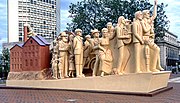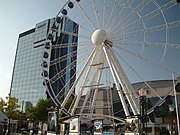
Birmingham Central Library was the main public library in Birmingham, England, from 1974 until 2013, replacing a library opened in 1865 and rebuilt in 1882. For a time the largest non-national library in Europe, it closed on 29 June 2013 and was replaced by the Library of Birmingham. The building was demolished in 2016, after 41 years, as part of the redevelopment of Paradise Circus by Argent Group. Designed by architect John Madin in the brutalist style, the library was part of an ambitious development project by Birmingham City Council to create a civic centre on its new Inner Ring Road system; however, for economic reasons significant parts of the master plan were not completed, and quality was reduced on materials as an economic measure. Two previous libraries occupied the adjacent site before Madin's library opened in 1974. The previous library, designed by John Henry Chamberlain, opened in 1883 and featured a tall clerestoried reading room. It was demolished in 1974 after the new library had opened.
William James Bloye was an English sculptor, active in Birmingham either side of World War II. After serving in World War I, Bloye studied and later taught at the Birmingham School of Art. Becoming a member of the Birmingham Civic Society in 1925, he played a significant role as Birmingham's unofficial civic sculptor, contributing to various public commissions. Bloye was a member of the Royal British Society of Sculptors, attaining the status of fellow in 1938. His association with the Royal Birmingham Society of Artists (RBSA) included serving as its president from 1948 to 1950 and as the Professor of Sculpture. He retired in 1956 and died away in 1975.

The Hall of Memory is a war memorial in Centenary Square, Birmingham, England, designed by S. N. Cooke and W. N. Twist. Erected 1922–25 by John Barnsley and Son, it commemorates the 12,320 Birmingham citizens who died in World War I.

Chamberlain Square or Chamberlain Place is a public square in central Birmingham, England, named after statesman and notable mayor of Birmingham, Joseph Chamberlain. The Victorian square was drastically remodelled in the 1970s, with most of the Victorian buildings demolished and the construction of the Brutalist Central Library. Re-landscaping occurred most recently when the square was closed to the public for five years until March 2021 for remodelling as part of the Paradise scheme.

Victoria Square is a pedestrianised public square in Birmingham, England. It is home to both the Town Hall and the Council House, and directly adjacent to Chamberlain Square. It is named in honour of Queen Victoria.

Aston Hall is a Grade I listed Jacobean house in Aston, Birmingham, England, designed by John Thorpe and built between 1618 and 1635. It is a leading example of the Jacobean prodigy house.

Five Ways is an area of Central Birmingham, England. It takes its name from a major road junction, now a busy roundabout to the south-west of the city centre which lies at the outward end of Broad Street, where the Birmingham Middle ring road crosses the start of the A456.

The Old Market Square is an open, pedestrianised city square in Nottingham, England, forming the heart of the city, and covering an area of approximately 12,000 square metres (130,000 sq ft), or about 3 acres (1.2 ha). It is one of the largest paved squares in the United Kingdom.

The Big City Plan is a major development plan for the city centre of Birmingham, England.

Belfast City Hall is the civic building of Belfast City Council located in Donegall Square, Belfast, Northern Ireland. It faces North and effectively divides the commercial and business areas of the city centre. It is a Grade A listed building.

Piccadilly Gardens is a green space in Manchester city centre, England, on the edge of the Northern Quarter.

Baskerville House, previously called the Civic Centre, is a former civic building in Centenary Square, Birmingham, England. After serving as offices for the Birmingham City Council, it was extended with additional floors in 2007.

William Joseph Haywood was an English architect, urban planner and secretary of The Birmingham Civic Society for twenty-nine years, being a founder member in 1918.

St Peter's Square is a public square in Manchester city centre, England. The north of the square is bounded by Princess Street and the south by Peter Street. To the west of the square is Manchester Central Library, Midland Hotel and Manchester Town Hall Extension. At the centre of the square is St Peter's Square Metrolink tram stop, a major transport interchange. The square is also home to the Manchester Cenotaph, and the statue of Emmeline Pankhurst Rise up, Women In 1819, the area around the square was the site of the Peterloo Massacre.

The King Edward VII Memorial is a sculpture in memory of King Edward VII, relocated from Highgate Park to Centenary Square, Birmingham, England.
This article is intended to show a timeline of events in the History of Birmingham, England, with a particular focus on the events, people or places that are covered in Wikipedia articles.

Birmingham city centre, also known as Central Birmingham, is the central business district of Birmingham, England. The area was historically in Warwickshire. Following the removal of the Inner Ring Road, the city centre is now defined as being the area within the Middleway ring road. In recent years the city centre has been undergoing massive redevelopment with the Big City Plan, which means there are now nine emerging districts and the city centre is approximately five times bigger.
Samuel Nathaniel Cooke Jr. was an English architect active in Birmingham, England in the early to mid 20th century. He was almost invariably credited as S. N. Cooke and his later work was carried out under the auspices of his firm S. N. Cooke and Partners. Works by him and the partnership include significant civic buildings, hospitals, and commercial premises in Birmingham and elsewhere in the United Kingdom.

Paradise, formerly named Paradise Circus, is the name given to an area of approximately 7 hectares in Birmingham city centre between Chamberlain and Centenary Squares. The area has been part of the civic centre of Birmingham, England since the 19th century when it contained buildings such as the Town Hall, Mason Science College, Birmingham and Midland Institute buildings and Central Library. The site was redeveloped from 1960 to 1975 into the present Paradise Circus based within a roundabout on the Inner Ring Road system containing a new Central Library and School of Music. From 2015, Argent Group will redevelop the area into new mixed use buildings and public squares. The Queensway Tunnel runs underneath the area.






















